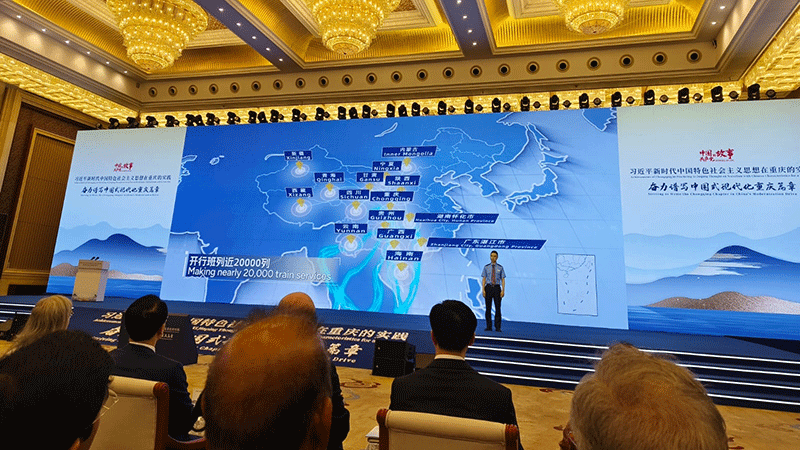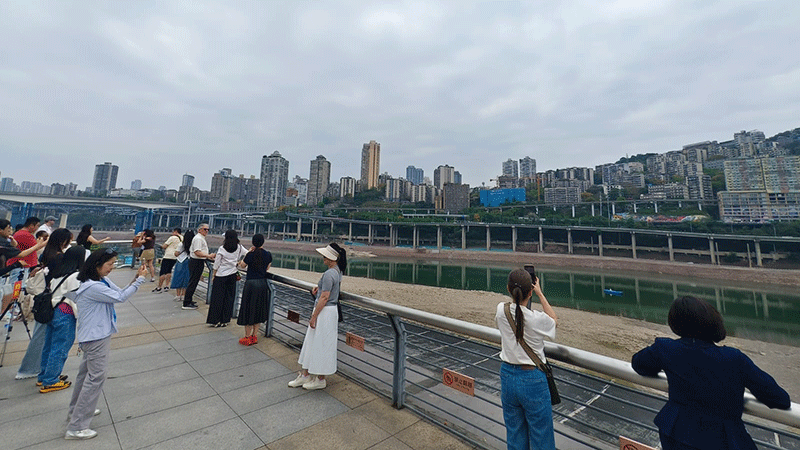 |
The driver of the first freight train travelling from Chongqing to Europe shares his experiences about the train passing through Kazakhstan, Russia, Belarus and Poland before reaching Duisburg in Germany.
|
Chongqing: A pillar of China’s global trade network and a manufacturing powerhouse
As the Belt and Road Initiative (BRI) continues gaining momentum, Chongqing city stands as a strategic powerhouse in advancing the global infrastructure project to bolster trade and economic cooperation.
Located in southwest China, the megacity is a gateway of the BRI, connecting to 560 ports in 127 countries and regions around the world through the China-Europe Express, the New Western Land-Sea Corridor, and the Maritime Silk Road.
Europe-to-Southeast Asia gateway
As a starting point on the China-Europe freight train network, a hallmark of the BRI, Chongqing has been transformed from an inland city to a vital connector between Europe to China and Southeast Asia where rail link is being accelerated.
Freight trains from Chongqing travel more than 11,000 km to reach Europe, crossing the border at Alashankou in the Xinjiang Uygur autonomous region. The railway then passes through Kazakhstan, Russia, Belarus and Poland before reaching Duisburg in Germany.
 |
Visitors take photos at a popular picturesque spot of Chongqing.
|
Cost-effective logistics alternative
Presentations delivered at the Economic and Trade Promotion Conference held recently in Chongqing indicate that rail freight transport offers cost-effective alternatives, filling the gap left by costly air transport and time-consuming maritime routes. Costs typically amount to just one-fifth of air freight, and the transit time is one-quarter that of sea transport, China Daily reported.
Coupled with a strong record of safe, stable and efficient shipment, services of the China-Europe Freight train have rapidly expanded from a handful of routes when it was first launched in 2011 to covering at least 227 cities in 25 European countries and more than 100 cities in 11 Asian countries.
Travelling to Southeast Asia, a freight train starting from Chongqing and onwards to Padang Besar in Malaysia, through Laos and Thailand, takes just 13 days to reach its destination, cutting travel time by half compared to the previous route. In the past, all cargo coming from other parts of China had to pass through Shanghai first via the Yangtze River, before reaching Penang in Malaysia by sea.
Operated under the International Land-Sea Trade Corridor, the Chongqing-Malaysia rail freight service, which also cuts costs, leverages the combination of two existing rail lines – the standard gauge used by railways in China and the Laos-China Railway, and the one-metre gauge track used by the Laos-Thailand railway. Cargo is speedily moved between the two tracks in the Lao capital Vientiane, where they converge to enable a seamless connection.
China-Laos-Thailand rail network being accelerated
The China-Laos-Thailand rail link, which uses a standard gauge track and is part of the broader Kunming-Singapore rail network, is being accelerated, as reported at the Chongqing conference.
By 2030, Thailand expects to complete its under-construction 609-km (378 mile) high-speed rail to link the capital, Bangkok, with the Laos-China Railway in Vientiane, Laos, the Bangkok Post reported.
 |
A night view of the vibrant Chongqing city.
|
China’s global manufacturing hub
Blessed with a comprehensive logistics system and a business-friendly climate, Chongqing – home to 32 million people – has earned its place as an investment destination and a global manufacturing hub.
Spanning an area of 82,400 sq km, the mountainous city currently hosts 322 Fortune Global 500 companies, with more than 7,200 foreign-invested enterprises. By 2024, one out of every eight cars and three motorcycles in China was produced in Chongqing, and between 30 to 35 percent of laptops worldwide are made here.
Driver of new energy vehicles
SERES, the Chongqing-based manufacturer of new energy vehicles (NEV), has shipped these vehicles to more than 70 countries and regions, with a cumulative export volume of 550,000 complete vehicles, thus bolstering China’s position as a global leader in the NEV industry and making a significant contribution to a greener future and climate change mitigation.
China’s NEV sales accounted for 70 percent of the world’s total sales between January and November 2024, the Global Times reported. Total sales of NEVs in China alone reached 11 million units that year.
To keep pace with this growing trend, traditional automakers, including BYD, have quickly embraced electric and digital technologies, while tech firms such as Xiaomi are entering the race in the EV auto sector, driving market competition and advancement of the industry.
Supported by the strategic industrial policy initiative, “Made in China 2025”, Chinese automakers have raced to embrace electric and cutting-edge digital technologies in a bid to outperform their rivals.
“SERES goes with the trend and takes the initiative. We insist on software-defined cars, and independently master the core technologies of intelligent and electrified automotive industries,” Gavin Liu, President Assistant, Overseas Business Unit of the SERES Group, said.
Testament to China’s opening up
Being China’s earliest inland trading port and opening up to the outside world more than 100 years ago, Chongqing’s remarkable progress is a testament to China’s commitment to opening up for win-win cooperation.
Built on this success, the municipality, which is directly under the central government, is intensifying efforts to embrace opening up, leveraging its strategic position as a key logistics hub connecting western China to the outside world.
Concluding his presentation, a Member of the Political Bureau of the Communist Party of China (CPC)’s Central Committee and Secretary of the CPC Chongqing Municipal Committee, Yuan Jiajun said that the city is “deepening engagement with the Belt and Road countries and regions”.
Foreign business communities in China have welcomed the mutually beneficial engagement, underscoring their business interest in the world’s second largest economy.
The Chairman of Government Affairs of the British Chamber of Commerce in China, Chris Torrens, hailed the improving UK-China ties as Prime Minister Keir Starmer’s new government has sought to rebuild trust and boost economic relations.
“UK companies are committed to support economic growth in Chongqing and across the country,” he told an audience at the Chongqing event.
The Vice Chairman-cum-Secretary General of the Singapore Chamber of Commerce and Industry in China, Warren Wee, said China’s strong economic outlook, driven by its large domestic market, advancing technology, and improving business environment, offers abundant opportunities for global enterprises, with Chingqing as a key attractive location.
“I believe that in the future, as our cooperation deepens, more Singaporean enterprises will achieve success on this vibrant land of Chongqing, continuing the wonderful chapters of China-Singapore cooperation,” he told the Chongqing conference.
The conference coincided with a recent 10-day media seminar. Organised by the International Department of the Communist Party of China (CPC)’s Central Committee, the seminar brought together representatives of media and political parties from across the world.
By
Souksakhone Vaenkeo
(Latest Update June 6, 2025)
|




